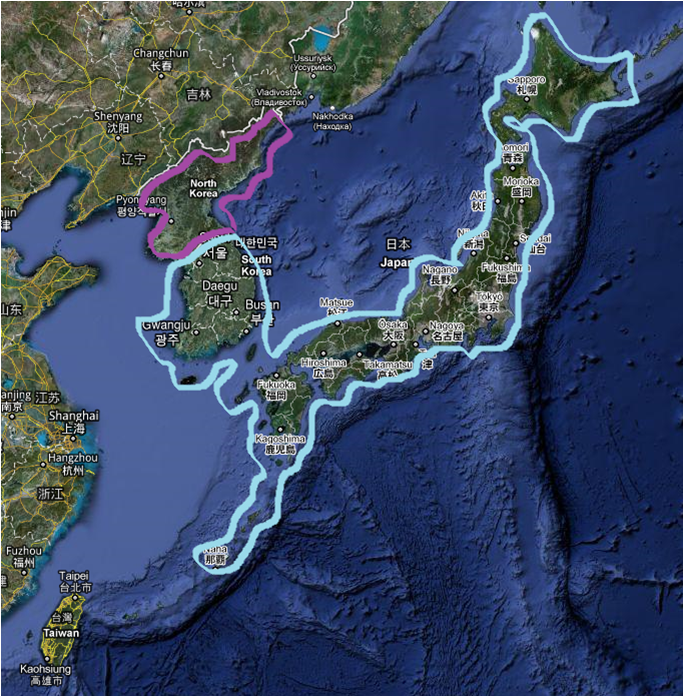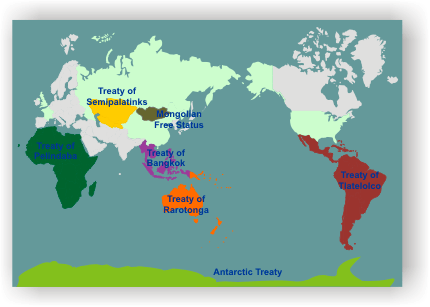Korea-Japan Nuclear Weapon Free Zone (KJNWFZ) Concept Paper
Special Report: September 15th, 2010
By the Nautilus Institute[1]
CONTENTS:
IV. Nautilus invites your responses
This concept paper is also available in Korean and Japanese.
I. SUMMARY INTRODUCTION
 A Korea-Japan [2] Nuclear Weapon Free Zone (hereafter KJNWFZ) is a new concept. Once realized, it could help resolve a number of linked and intractable security issues in Northeast Asia at the same time. This includes the need to respond to North Korea’s nuclear breakout without undermining the Global Abolition policy announced by President Obama; the need for Japan and Korea to deepen their non-nuclear commitments to more deeply ingrained “forever” status without hedging; and the need for Japan-Korean cooperation to lay the foundations for a comprehensive security mechanism and long-term regional security institution, including through cooperative nuclear fuel cycle and space development activities.
A Korea-Japan [2] Nuclear Weapon Free Zone (hereafter KJNWFZ) is a new concept. Once realized, it could help resolve a number of linked and intractable security issues in Northeast Asia at the same time. This includes the need to respond to North Korea’s nuclear breakout without undermining the Global Abolition policy announced by President Obama; the need for Japan and Korea to deepen their non-nuclear commitments to more deeply ingrained “forever” status without hedging; and the need for Japan-Korean cooperation to lay the foundations for a comprehensive security mechanism and long-term regional security institution, including through cooperative nuclear fuel cycle and space development activities.
Section 1 of this paper outlines the core concept of a nuclear weapon free zone (NWFZ), reviews past proposals for Northeast Asia NWFZs, and delineates the minimal and region specific issues that a KJNWFZ must address. Section 2 outlines in more detail the Nautilus KJNWFZ Initiative, lists the possible costs, benefits, and risks posed by a KJNWFZ, and describes the research needed to ascertain the feasibility and desirability of a KJNWFZ. Section 3 explains why a KJNWFZ is timely and apt given the failure to stop North Korean nuclear armament and follow-on effects for US alliances and regional security.
1. CORE CONCEPT
1 Contact Peter Hayes, peter@nautilus.org
6 S. Duarte, “The Future of Nuclear-Weapon-Free Zones: Maintaining their Relevance and Expanding their Scope,” remarks at Preparing for 2010: Striking a Balance between Nuclear Disarmament and Nuclear Nonproliferation, James Martin Center for Nonproliferation Studies, Monterey Institute of International Studies, 7 March 2008, at: http://www.un.org/disarmament/HomePage/HR/docs/2008/2008March07_Annecy.pdf
9 For an overview of these differences, see M. Marzo, “The Denuclearization Agreements and the Future,” September 2005, at: http://www.abacc.org/engl/publications_speeches/publications_articles_article.asp?artigo_id=8
11 See in particular, John Endicott, “Limited Nuclear-Weapon-Free Zones: The Time Has Come”, Korean Journal of Defense Analysis, 20:1, March 2008; and Umebayashi Hiromichi, “Towards a Northeast Asia Nuclear Weapon-Free Zone”, Japan Focus, August 11 2005, http://japanfocus.org/products/topdf/1784. These various proposals are described in Peter
13 S.W. Cheon and T. Suzuki’s 2003 examination of a zone that includes the two Koreas and Japan comes closest and is extremely valuable in anticipating many issues involved in a KJNWFZ, but aims more at facilitating early entry by a denuclearized DPRK into a tripartite zone, whereas the proposal in this paper assumes the DPRK may join only later or never. See their “The Tripartite Nuclear-Weapon-Free Zone in Northeast Asia:, a Long-Term Objective of the Six Party Talks,” International Journal of Korean Studies, 12, 2, 2003, pp. 41-68.
15 Existential deterrence is a phrase coined by McGeorge Bundy during the Cold War; today it refers to the caution induced in decision makers by the mere existence of nuclear weapons, given their awesome and unique destructive potential, including annihilation of cities, countries and even the human species. This caution may arise in the states that deploy nuclear weapons, in states that are vulnerable to nuclear attack, or in third parties who might be affected politically or militarily, or by damages such as radioactive fallout or nuclear winter. It arguably exists as a backdrop to international affairs, even in cases where no nuclear weapons are deployed or targeted.
16 P. Morgan, “Retracting Nuclear Umbrellas in Northeast Asia—the Case of Korea,” forthcoming NAPSNet Policy Forum On-line.
17 See P. Hayes, “Extended Nuclear Deterrence, Global Abolition, and Korea,” The Asia Pacific Journal, No. 50. 2009, December 14, 2009, at: http://japanfocus.org/-Peter-Hayes/3268



One thought on “Korea-Japan Nuclear Weapon Free Zone (KJNWFZ) Concept Paper”